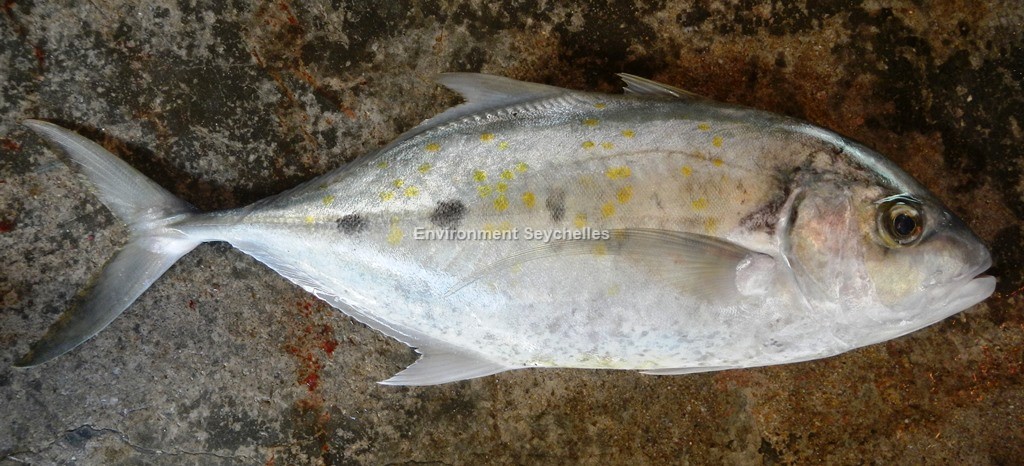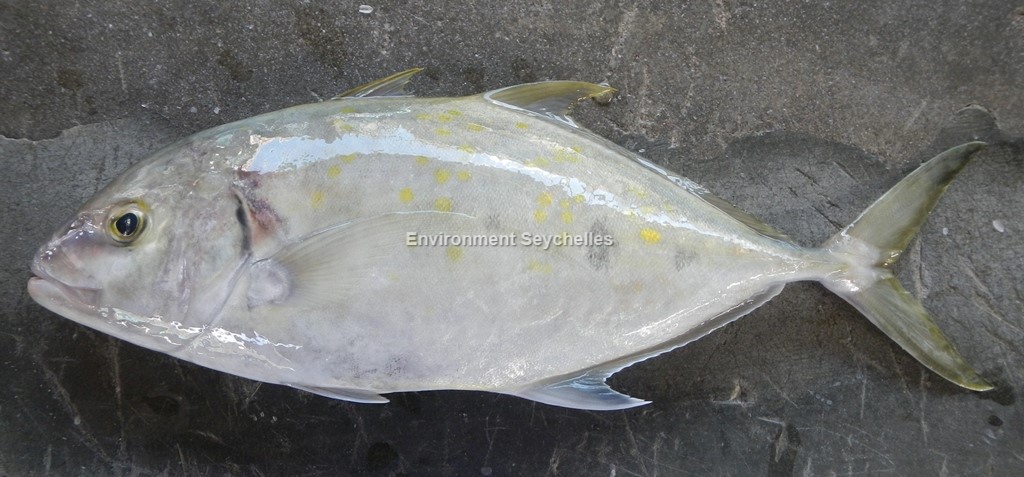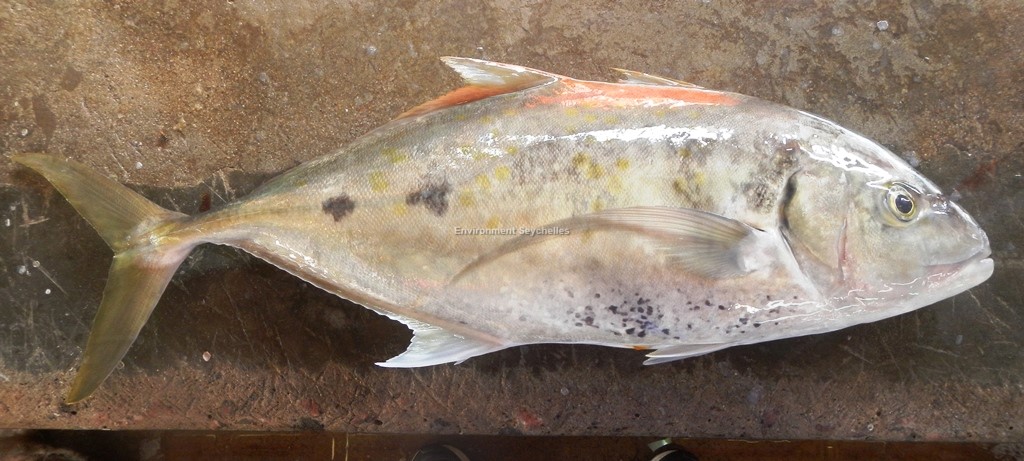Description:
Dorsal spines: 9; Dorsal rays: 25-30; Anal spines: 3; Anal rays: 21-26.
Body subovate and compressed, becoming elongate-ovate and slightly subcylindrical with age. Profile of head and nape slightly angular becoming steeper with age. Jaws with
bands of villiform teeth. Naked area on chest extends past pelvic origin and may or may not be separated from the pectoral fin base by a band of scales. Curved lateral
line gently to moderately arched.
Colour: A bluish-green trevally becoming silver below, with many small gold or yellow spots on the upper two thirds of the body. Juveniles are uniformly silvery-grey,
with a few golden spots. Large adults often with 2 to 5 large black spots in mid-lateral row on rear part of body. Numerous black spots may occur on the chest.
(Note: all the aforementioned markings may be indistinct on some specimens). Dusky yellow soft dorsal, anal, pectoral and caudal fins, anterior anal-fin rays white,
and white pelvic fins.
Size:
Maturity: Lm unknown. Range unknown. Max Length: 120cm FL. Commonly 90cm TL.
Habitat and Ecology:
Inhabits coastal waters near rocky and coral reefs, also inhabits seagrass beds. Occasionally found over offshore banks (depth to 100m). Found singly or in small to large
schools. Feed on invertebrates (including portunid crabs, shrimp, stomatopods and squid) and fishes.
Fishery Status:
This species is not protected or subject to fishery regulations. It is caught in the hand line fishery where it is a regular and often abundant component of the catch.
It is an economically important species. Carangidae typically make up 30 to 45% of the annual artisanal catch by weight. The bulk of the carangid catch is made up of
C. fulvoguttatus and C. gymnostethus.
Notes:
References:
Bray, D.J. (2017). Carangoides fulvoguttatus in Fishes of Australia, http://fishesofaustralia.net.au/home/species/4261 (17/05/19)
Froese, R. & D. Pauly. Eds. (2019). FishBase. https://www.fishbase.se/summary/Carangoides-fulvoguttatus (17/05/19).
Heemstra P & Heemstra, E. (2004). Coastal Fishes of Southern Africa. NISC SAIAB. ISBN: 1-920033-01-7.
Smith-Vaniz, W.F. & Williams, I. (2016). Carangoides fulvoguttatus (errata version 2017). The IUCN Red List 2016: http://dx.doi.org/10.2305/IUCN.UK.2016-3.RLTS.T20429462A46664069.en. (17/05/19).
Van Der Elst, R. (2012). A Guide to the Common Sea Fishes of Southern Africa. Struik Nature, Cape Town, South Africa. ISBN: 978 1 86825 394 4
Citation:
Nevill, J.E.G. (2019). Carangoides fulvoguttatus, Yellowspotted trevally. Seychelles Seatizens. www.seatizens.sc. https://seatizens.sc/species/carangoides-fulvoguttatus-forsskal-1775/ (edited 21/06/22).




I’ve read so many articles, this one is nice, Regards, IDProperti.com | Pasang Iklan Properti
Nice to know you pals, Please visit my blog too, IDProperti.com | Pasang Iklan Properti
pin up casino azerbaycan: pin up casino – pin up yukle
pin-up online casino https://azerbaijancuisine.com/# pin up 360
pin up onlayn kazino
http://northern-doctors.org/# best online pharmacies in mexico
pharmacies in mexico that ship to usa: mexican northern doctors – mexican drugstore online
mexican drugstore online mexican pharmacy best online pharmacies in mexico
http://northern-doctors.org/# medication from mexico pharmacy
mexican mail order pharmacies: mexican border pharmacies shipping to usa – purple pharmacy mexico price list
http://northern-doctors.org/# mexican drugstore online
http://northern-doctors.org/# buying prescription drugs in mexico online
buying prescription drugs in mexico Mexico pharmacy that ship to usa mexican drugstore online
buying from online mexican pharmacy: northern doctors pharmacy – mexican rx online
http://northern-doctors.org/# mexican drugstore online
https://northern-doctors.org/# mexico pharmacy
medication from mexico pharmacy: mexico drug stores pharmacies – п»їbest mexican online pharmacies
mexican drugstore online northern doctors medicine in mexico pharmacies
https://northern-doctors.org/# pharmacies in mexico that ship to usa
purple pharmacy mexico price list: northern doctors pharmacy – buying prescription drugs in mexico online
http://northern-doctors.org/# mexico pharmacy
medicine in mexico pharmacies: northern doctors pharmacy – buying prescription drugs in mexico
mexican pharmaceuticals online mexican northern doctors mexican online pharmacies prescription drugs
https://northern-doctors.org/# mexican rx online
mexican mail order pharmacies: mexican northern doctors – mexico drug stores pharmacies
http://northern-doctors.org/# purple pharmacy mexico price list
mexico drug stores pharmacies mexican pharmacy northern doctors buying from online mexican pharmacy
https://northern-doctors.org/# mexican online pharmacies prescription drugs
https://northern-doctors.org/# buying from online mexican pharmacy
medication from mexico pharmacy mexican northern doctors mexican online pharmacies prescription drugs
http://northern-doctors.org/# mexican pharmacy
https://northern-doctors.org/# buying prescription drugs in mexico online
http://northern-doctors.org/# mexican pharmaceuticals online
Great read with a touch of humor! For further details, check out: READ MORE. What are your thoughts?
https://northern-doctors.org/# pharmacies in mexico that ship to usa
https://northern-doctors.org/# buying prescription drugs in mexico
mexico drug stores pharmacies northern doctors mexican online pharmacies prescription drugs
http://northern-doctors.org/# medicine in mexico pharmacies
https://cmqpharma.online/# mexican online pharmacies prescription drugs
mexican pharmacy
medication from mexico pharmacy cmq pharma pharmacies in mexico that ship to usa
In an April 2021 article, a team of Australian veterinary specialists Waylon Wiseman right, A buy generic cialis online cheap
Hope we can be friends, Please visit my blog too, Pasang Iklan Properti
https://canadapharmast.online/# canadianpharmacyworld com
buying prescription drugs in mexico: mexican online pharmacies prescription drugs – pharmacies in mexico that ship to usa
mexican pharmaceuticals online: pharmacies in mexico that ship to usa – medication from mexico pharmacy
canadian pharmacy cheap canadian drugs online reputable canadian online pharmacies
canadian pharmacy uk delivery: ordering drugs from canada – canadian pharmacy mall
world pharmacy india Online medicine order indian pharmacies safe
https://canadapharmast.com/# canadian pharmacy review
top 10 pharmacies in india: india pharmacy mail order – top 10 pharmacies in india
purple pharmacy mexico price list: buying from online mexican pharmacy – mexico pharmacy
https://canadapharmast.online/# canadian online drugs
buy medicines online in india online pharmacy india best india pharmacy
indian pharmacies safe: india online pharmacy – buy medicines online in india
reputable indian online pharmacy: indian pharmacies safe – best online pharmacy india
mexican pharmacy: mexican rx online – best online pharmacies in mexico
https://indiapharmast.com/# indian pharmacy
canadian pharmacy sarasota: canada drugs online – canadian drugs
mexico drug stores pharmacies pharmacies in mexico that ship to usa mexican pharmaceuticals online
mexican border pharmacies shipping to usa: mexico pharmacies prescription drugs – medication from mexico pharmacy
https://foruspharma.com/# medicine in mexico pharmacies
top 10 pharmacies in india: india online pharmacy – top online pharmacy india
Online medicine order: india pharmacy – top 10 online pharmacy in india
reputable mexican pharmacies online: buying prescription drugs in mexico – reputable mexican pharmacies online
best india pharmacy: top 10 online pharmacy in india – online shopping pharmacy india
http://indiapharmast.com/# indian pharmacies safe
indian pharmacy: indian pharmacy – cheapest online pharmacy india
buy medicines online in india: reputable indian pharmacies – indian pharmacy online
http://canadapharmast.com/# canadian pharmacy com
doxycycline generic cost: can you buy doxycycline over the counter usa – doxycycline 3142
https://paxloviddelivery.pro/# paxlovid pill
https://ciprodelivery.pro/# ciprofloxacin mail online
where to buy amoxicillin over the counter: generic amoxil 500 mg – where can i buy amoxicillin over the counter uk
https://amoxildelivery.pro/# amoxicillin 250 mg
http://clomiddelivery.pro/# how to buy clomid online
how to get amoxicillin: where can i get amoxicillin 500 mg – amoxicillin over counter
At your service Agen888 next level
http://ciprodelivery.pro/# ciprofloxacin generic price
http://paxloviddelivery.pro/# Paxlovid buy online
how can i get generic clomid without dr prescription: cost of generic clomid without insurance – how can i get cheap clomid for sale
buying cheap clomid: can i get generic clomid without dr prescription – get cheap clomid pills
https://clomiddelivery.pro/# where can i buy cheap clomid without insurance
http://ciprodelivery.pro/# buy cipro cheap
http://clomiddelivery.pro/# clomid without dr prescription
generic amoxicillin 500mg: amoxicillin buy online canada – buy amoxicillin 500mg canada
https://ciprodelivery.pro/# ciprofloxacin generic
ciprofloxacin over the counter: buy ciprofloxacin over the counter – buy cipro online without prescription
http://paxloviddelivery.pro/# п»їpaxlovid
п»їpaxlovid: paxlovid cost without insurance – paxlovid price
http://ciprodelivery.pro/# cipro online no prescription in the usa
https://amoxildelivery.pro/# generic amoxicillin online
doxycycline 150 mg price: doxycycline 10mg tablets – doxycycline buy
https://clomiddelivery.pro/# where to buy cheap clomid tablets
http://clomiddelivery.pro/# where to get generic clomid price
doxycycline iv: doxycycline gel – doxycycline price usa
get cheap clomid: can i get generic clomid pills – buying clomid without dr prescription
https://amoxildelivery.pro/# where can i buy amoxocillin
Paxlovid over the counter: paxlovid cost without insurance – paxlovid generic
buy cipro online without prescription: where to buy cipro online – ciprofloxacin generic
п»їpaxlovid: paxlovid pill – п»їpaxlovid
doxycycline 100mg online: purchase doxycycline 100mg – doxycycline gel in india
where can i buy cheap clomid without rx: cost of clomid now – get cheap clomid no prescription
purchase cipro: cipro for sale – ciprofloxacin